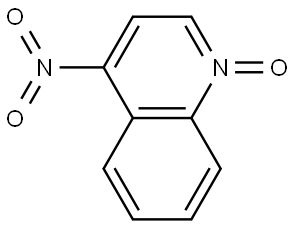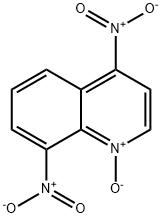4-NITROQUINOLINE N-OXIDE
Synonym(s):4-Nitroquinoline 1-oxide;4-NQO
- CAS NO.:56-57-5
- Empirical Formula: C9H6N2O3
- Molecular Weight: 190.16
- MDL number: MFCD00006738
- EINECS: 200-281-1
- SAFETY DATA SHEET (SDS)
- Update Date: 2024-12-18 14:07:02

What is 4-NITROQUINOLINE N-OXIDE?
Chemical properties
yellow-brown crystals or powder
The Uses of 4-NITROQUINOLINE N-OXIDE
4-Nitroquinoline N-Oxide is used in method for constructing animal model of oral mucosal malignancy related to Kras mutation.
The Uses of 4-NITROQUINOLINE N-OXIDE
4-Nitroquinoline N-oxide has been used as a model compound to study its carcinogenic effects.
What are the applications of Application
4-Nitroquinoline N-oxide is a model compound uesd to study carcinogenic effects, as it itself is a skin and lung tumor initiator.
Definition
ChEBI: A quinoline N-oxide carrying a nitro substituent at position 4.
General Description
Yellowish-brown plates or needles or yellow solid.
Air & Water Reactions
4-NITROQUINOLINE N-OXIDE is hygroscopic and light sensitive. Insoluble in water.
Reactivity Profile
4-NITROQUINOLINE N-OXIDE reacts with strong oxidizing agents.
Health Hazard
ACUTE/CHRONIC HAZARDS: 4-NITROQUINOLINE N-OXIDE may cause irritation. When heated to decomposition it may emit toxic fumes of carbon monoxide, carbon dioxide and nitrogen oxides.
Fire Hazard
Flash point data for 4-NITROQUINOLINE N-OXIDE are not available; however, 4-NITROQUINOLINE N-OXIDE is probably combustible.
Biochem/physiol Actions
Skin and lung tumor initiator under experimental conditions.
Safety Profile
Suspected carcinogen with experimental carcinogenic, neoplas tigenic, and tumorigenic data. Poison by intraperitoneal and subcutaneous routes. An experimental teratogen. Other experimental reproductive effects. Human mutation data reported. When heated to decomposition it emits toxic fumes of NOx.
Purification Methods
The N-oxide recrystallises from aqueous acetone as yellow needles or platelets. [Ochiai J Org Chem 18 534 1953, Seki et al. J Phys Chem 91 126 1987, Beilstein 20 III/IV 3396.]
Properties of 4-NITROQUINOLINE N-OXIDE
| Melting point: | 154-156 °C(lit.) |
| Boiling point: | 325.64°C (rough estimate) |
| Density | 1.42 |
| refractive index | 1.5570 (estimate) |
| storage temp. | -20°C |
| solubility | acetone: clear to hazy |
| form | Crystalline Solid |
| pka | -1.83±0.10(Predicted) |
| color | yellow to brown |
| BRN | 165756 |
| Stability: | Stable. Hygroscopic, light-sensitive. Incompatible with strong oxidizing agents. |
| CAS DataBase Reference | 56-57-5(CAS DataBase Reference) |
| EPA Substance Registry System | 4-Nitroquinoline 1-oxide (56-57-5) |
Safety information for 4-NITROQUINOLINE N-OXIDE
| Signal word | Danger |
| Pictogram(s) |
 Health Hazard GHS08 |
| GHS Hazard Statements |
H350:Carcinogenicity |
| Precautionary Statement Codes |
P201:Obtain special instructions before use. P308+P313:IF exposed or concerned: Get medical advice/attention. |
Computed Descriptors for 4-NITROQUINOLINE N-OXIDE
| InChIKey | YHQDZJICGQWFHK-UHFFFAOYSA-N |
New Products
4-Fluorophenylacetic acid 4-Methylphenylacetic acid N-Boc-D-alaninol N-BOC-D/L-ALANINOL Tert-butyl bis(2-chloroethyl)carbamate 3-Morpholino-1-(4-nitrophenyl)-5,6-dihydropyridin- 2(1H)-one Furan-2,5-Dicarboxylic Acid Tropic acid S-2-CHLORO PROPIONIC ACID ETHYL ISOCYANOACETATE 2-Bromo-1,3-Bis(Dimethylamino)Trimethinium Hexafluorophosphate (6-METHYL-[1,3]DITHIOLO[4,5-b]QUINOXALIN-2-ONE INDAZOLE-3-CARBOXYLIC ACID 4-IODO BENZOIC ACID (2-Hydroxyphenyl)acetonitrile 4-Bromopyrazole 5,6-Dimethoxyindanone 2-(Cyanocyclohexyl)acetic acid 4-methoxy-3,5-dinitropyridine 2-aminopropyl benzoate hydrochloride 1-(4-(aminomethyl)benzyl)urea hydrochloride diethyl 2-(2-((tertbutoxycarbonyl)amino) ethyl)malonate tert-butyl 4- (ureidomethyl)benzylcarbamate Ethyl-2-chloro((4-methoxyphenyl)hydrazono)acetateRelated products of tetrahydrofuran








You may like
-
 4-Nitroquinoline n-oxide, 98% CAS 56-57-5View Details
4-Nitroquinoline n-oxide, 98% CAS 56-57-5View Details
56-57-5 -
 4-Nitroquinoline N-Oxide CAS 56-57-5View Details
4-Nitroquinoline N-Oxide CAS 56-57-5View Details
56-57-5 -
 4-Nitroquinoline N-oxide CAS 56-57-5View Details
4-Nitroquinoline N-oxide CAS 56-57-5View Details
56-57-5 -
 1975-50-4 98%View Details
1975-50-4 98%View Details
1975-50-4 -
 2-HYDROXY BENZYL ALCOHOL 98%View Details
2-HYDROXY BENZYL ALCOHOL 98%View Details
90-01-7 -
 2-Chloro-1,3-Bis(Dimethylamino)Trimethinium Hexafluorophosphate 221615-75-4 98%View Details
2-Chloro-1,3-Bis(Dimethylamino)Trimethinium Hexafluorophosphate 221615-75-4 98%View Details
221615-75-4 -
 14714-50-2 (2-Hydroxyphenyl)acetonitrile 98+View Details
14714-50-2 (2-Hydroxyphenyl)acetonitrile 98+View Details
14714-50-2 -
 118753-70-1 98+View Details
118753-70-1 98+View Details
118753-70-1